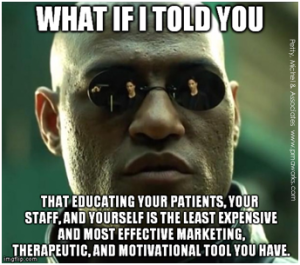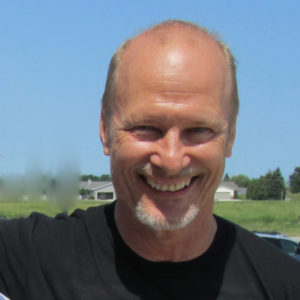
Forget about the roller tables, stretching bands, balance boards, traction devises, taping, decompression, protein powder, vibrating platforms, laser, lipo body sculpting, ultrasound, stim, tens, supplements, orthotics, etc.
Any or all of these may or may not be appropriate for your practice, but they should not be your first choice in providing a modality or ancillary service to your patients.
Think about this: what could you do for your patients, in addition to your adjustments, that would help them improve their health the most?
EDUCATE THEM
The more the patient knows about how chiropractic works – and how your services help them – the more motivated they will be in following through with their health care plan.
People don’t know about subluxations just like they really didn’t know about asbestos or cigarettes. It was a while ago but advertising was rampant on television and in print promoting cigarettes. MD’s were often used to legitimize the use of cigarettes.
Today, your patients are also being inundated with propaganda about food, drugs, and basic lifestyle choices that are not healthy, let alone not true. They are told that drugs are safe solutions for headaches, back pain, and other ailments when in many cases they are found to be poisonous. (Vioxx, Accutane, Cylert, Darvon & Darvocet, for example.) Nearly all the food they eat has various toxins, from aspartame in diet food to herbicides that linger (glyphosate, used in “Roundup” and sprayed on your kid’s schools playgrounds).
Educated patients are better equipped to keep to their treatment program and continue improving their health. Isn’t this what you want?
This is your #1 ancillary service.
#1 Marketing Tool
Educated patients are more motivated to refer those they know to you and to help you set up external events. They can become your ambassadors, field representatives and sales force. They know that someone with headaches, low back pain, or other odd symptoms may be helped by chiropractic and your services. They may be able to refer them directly, or you can help them by providing special workshops, special events, and opportunities for external programs at their place of work.
#1 Team Management Tool
All of this also applies to each of your team members as well.
We are all “numbed down” by a conventional lifestyle and a culture that is greatly manufactured by just a few large industries such as Big Pharma and Big Food that use media and government to achieve its ends.
And, frankly, we tend to take what we do for granted. Imagine a patient who had a headache for years and after your care is now pain free and can get a full night’s sleep and her relationships with her family have improved., etc. Amazing, right? But for us, pretty routine. We can end up being more concerned about billing her secondary or supplement insurance or keeping her scheduling than in just celebrating with her.
Almost anything you know about health care will be “new news” to your patients and probably many of your staff. Plus, we all tend to forget what we once knew.
What is the big difference with you from when you started chiropractic college and after you graduated (Besides debt) . THE difference was and is that you were motivated. And you were motivated because… you were educated and even more, you were enlightened. You were able to see things in people’s health conditions that you never saw before. And with all this understanding, you were now more motivated.
But in time, awareness can dim and so can motivation. New patients start dropping off, treatment plans get shorter, and the quality of staff performance erodes. The solution is to keep educating patients and team members so that they stay awake and motivated.
In other words, WAKE THE FLOCK UP!
Patient and staff education provide the best ROI of any activity you have. Modalities and extra services have many overlooked costs such as staff time to account and bill for the therapies, extra staff to apply the services, someone to take inventory of the products and to sell them, etc. Patient education is pretty much a no cost proposition. How much does a care class cost? Watching “Doctored” or “Food Inc. ” or “Bought” with your staff and then discussing it afterwards (that is very important), it is much cheaper than flying to Las Vegas.
And if you do it often and effectively, you will be able to afford that next seminar in Hawaii.
As the doctor, you are the CEO, the Chief Evangelizing Officer. I first heard this term from Guy Kawasaki, who was called this when he worked for Apple when the Macintosh was first launched in the early 80’s. Macintosh was trying to win over users from IBM computers to the Apple Macintosh.
You are creating converts to a chiropractic and natural health lifestyle.
Remember that education, both staff, patients, and your own education as well should cover not only what your services do, and how they do it, but WHY you provide these services. In fact, your emotional connection to the reason you do your services communicates the strongest.
WHAT TO DO
1. First, keep yourself aware and amazed at the innate healing power of the body and the great affects your services provide. Provide an hour or two of study for yourself each week. Just like you work IN your office, you have to work ON your office – and that includes yourself.
2. Let yourself get emotional about what the FLOCK is going on! Don’t be “correct”, well heeled and a good little domesticated “provider.” It is natural that you become somewhat “riled up” about the injustice that your patients and their family and friends experience in receiving “health care” or at the misinformation “fed” to people about healthy living.
3. Educate your team. Watch a movie with them and then have a discussion period afterwards. (The discussion is very important as it helps get everyone engaged in the process.)
4. Staff Meetings. Go over a case history or two.
5. Patient Care Class. There are many different names for this, but all patients get better, faster, and stay healthier longer if they know more about chiropractic and health. Make it a part of their treatment plan and bribe them with food!
6. Start a Lending Library and position your office as an educational facility. Even if you lose a few books or DVD’s each month, it is worth it as your patients will see that you are serious about health and health education. Give each staff member a bonus for a book report presentation at a staff meeting.
There are many ways to educate yourself, your team, and your patients. Done right, education turns into enlightenment and this will produce a greater return than many other activities you do.
# # #














